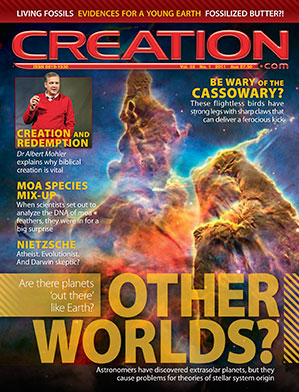Familiarity breeds … respect?
Editorial
Although widely respected, the Grand Theory of Evolution is really quite preposterous.

I have sometimes summarized the grand (or general) theory of evolution (GTE) thus:
Nothing exploded and produced hydrogen—the ‘big bang’. Then hydrogen stars exploded causing hydrogen atoms to jam together to form the heavier elements. From these elements stars as we know them formed, and galaxies and walls of galaxies—the whole universe. And then, from a swirling disc of cosmic dust left over from some exploding stars, our Solar System formed, with the accreting matter in the centre finally achieving enough mass to ignite nuclear fusion—the Sun. And earth had formed, with the other planets, all with very different characteristics. Earth happened to be in the right place to be suitable for life. Initially a molten blob, it finally cooled down enough for water to form. In the water, complex organic chemicals made themselves and (contrary to everything we know about the chemistry of life) chanced to form the first living cell. And this first cell changed, over eons of time, by accidental changes, to produce every living thing on earth, including microbes, magnolias and microbiologists. And the human mind. It all happened by happenstance; no intelligence allowed!
A short summary of this fashionable ‘scientific’ belief system could be: “Hydrogen is a gas, which if left long enough, turns into people.” The non-rational produced the rational.
Presenting this overview has at times offended some people. Why? The big-picture summary exposes the GTE as being quite fanciful, incredible beyond the bounds of reason. The offended have come to believe this far-fetched story, possibly because they have heard it reinforced by so many authoritative sources, such as their school teachers, college/university professors and ‘experts’ on the Discovery channel or in National Geographic. They have based a God-less lifestyle on this and feel threatened when the foundation of their atheistic worldview is exposed as bogus.
Contemplating the GTE recently, I came to a fresh realization of just how ridiculous it is. Yes, I’m sorry, ridiculous. This grew out of a discussion I had with an atheist, whom I challenged about his logic-defying beliefs. We creationists can forget just how preposterous the GTE is. When you are dealing daily with the details, such as the latest super-trivial claim that some fish adapting to slightly colder water ‘proves evolution’ (p.11), you tend to lose sight of how fanciful the big claim is. I mean, how can nothing become everything (the Universe) with no cause whatsoever? This is the stuff of madness. The origin of life? Even the simplest microbe has stupendous integrated complexity far beyond human ability to invent. It just popped into existence by the blind forces of chemistry and physics? This is lunacy.
So why do intelligent people believe such impossible things?
Perhaps the continual focus on little bits of the story contributes to the wide acceptance of the grand evolutionary story; rarely does anyone step back and look at the BIG picture. Maybe some have never heard anything else. But more importantly, ‘everything made itself’ means that the Creator-God of the Bible can be pushed aside.
True believers in GTE get upset when we expose their worldview in such a strong way. As C.S. Lewis pointed out long ago, people love the myth. He counselled that we need to let them down gently,1 which accords with the Apostle Peter’s advice to give our reasons “with gentleness and respect” (1 Peter 3:15).
References
- Hardgrave, D., C.S. Lewis and the Great Myth: They love the Myth so take care how you expose it, creation.com/cs-lewis-and-the-great-myth, 1 January 2008. Return to text.


Readers’ comments
Comments are automatically closed 14 days after publication.